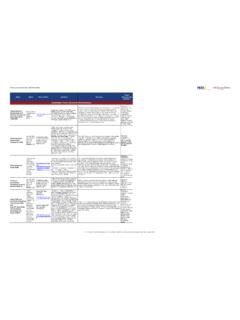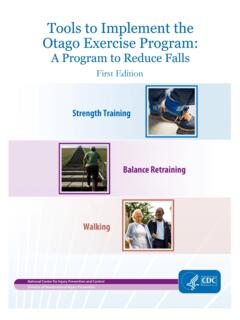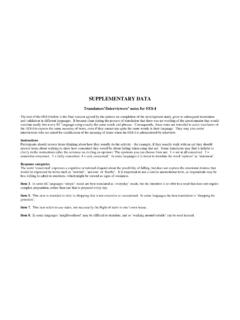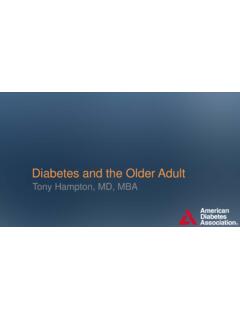Transcription of Preventing Falls: How to Develop Community-based Fall ...
1 Preventing FALLS: A Guide to Implementing Effective Community-based fall Prevention Programs Preventing Falls: A Guide to Implementing Effective Community-based fall Prevention Programs 2nd Edition Division of Unintentional Injury Prevention National Center for Injury Prevention and Control Centers for Disease Control and Prevention Atlanta, Georgia 2015. This document is a publication of the National Center for Injury Prevention and Control of the Centers for Disease Control and Prevention: Centers for Disease Control and Prevention Thomas R. Frieden, MD, MPH, Director National Center for Injury Prevention and Control Debra Houry, MD, MPH, Director Division of Unintentional Injury Prevention Grant Baldwin, PhD, MPH, Director Home, Recreation, and Transportation Branch Ann Dellinger, PhD, MPH, Branch Chief Home and Recreation Injury Prevention Team Robin Lee, PhD, MPH, Team Lead ACKNOWLE DG E M E NTS. CDC would like to acknowledge the contributions of the Administration for Community Living (ACL) and Department of Housing and Urban Development (HUD) for their continued expertise and guidance on the development of this guide.
2 The partnership between CDC, ACL, and HUD is critical for advancing the use and uptake of effective fall prevention programs that can help safeguard the health of older Americans. Suggested Citation: National Center for Injury Prevention and Control. Preventing Falls: A Guide to Implementing Effective Community-based fall Prevention Programs. 2nd ed. Atlanta, GA: Centers for Disease Control and Prevention, 2015. Disclaimer: Reference herein to any specific commercial products, programs, or services by trade name, trademark, manufacturer, or otherwise, does not necessarily constitute or imply its endorsement, recommendation, or favoring by the United States Government. The views and opinions of authors expressed herein do not necessarily state or reflect those of the United States Government, and shall not be used for advertising or product endorsement purposes. iv CONTENTS. Chapter 1. Introduction .. 1. Why fall prevention is important .. 2. Understanding fall risk factors.
3 3. Effective interventions can prevent older adult falls .. 4. Purpose of this guide .. 4. Chapter 2. Planning for a fall Prevention Program .. 7. Determine your community's needs .. 7. Identify resources .. 8. Determine your organization's readiness .. 8. Selected web resources .. 9. Chapter 3. The Important Role of Partnerships .. 11. Developing partnerships .. 11. Maintaining partnerships .. 12. Building an infrastructure .. 13. Budget adequate resources .. 13. Selected web resources for developing partnerships .. 14. Chapter 4. Selecting an Evidence-Based fall Prevention Program .. 15. What is an evidence-based program? .. 15. Community fall prevention programs .. 15. Selecting a program .. 16. Program characteristics .. 17. Selected program web resources .. 18. Chapter 5. Raising Awareness about Your Program .. 19. Reaching your intended audience .. 19. Increasing public awareness .. 19. Developing a plan .. 20. Provider education .. 20. Public education.
4 21. Selected fall prevention education web resources .. 22. Chapter 6. Implementing Your fall Prevention Program .. 23. Identify your target audience .. 23. Think collaboratively .. 24. Recruiting program participants .. 26. Assuring program quality .. 27. v Appendix E Template for Developing a Sustainability Plan A GUIDE TO IMPLEMENTING EFFECTIVE Community-based fall PREVENTION PROGRAMS. Program fidelity .. 27. Continuous quality improvement (CQI) .. 29. Selected implementation web resources .. 29. Chapter 7. Evaluating Your fall Prevention Program .. 31. Introduction .. 31. Why evaluate? .. 32. Measuring program effectiveness .. 32. Goals .. 33. Evaluation methods .. 33. Types of data .. 34. Types of evaluation .. 35. Determining which method to use .. 36. Selected evaluation web resources .. 37. Chapter 8. Promoting Your fall Prevention Program .. 39. Conducting a successful campaign .. 39. Working with the media .. 41. Selected promotional web resources.
5 42. Chapter 9. Sustaining Your fall Prevention Program .. 43. Establish your vision .. 43. Build collaborations .. 44. Secure funding .. 44. Demonstrate benefits .. 45. Delivery infrastructure .. 45. Strategies for achieving financial sustainability .. 45. Selected sustainability web resources .. 47. Appendices .. 49. Appendix A Stay Independent brochure .. 49. Appendix B Educational Materials for older Adults .. 50. What YOU Can Do to Prevent Falls A fall prevention brochure .. 50. Check for Safety A home safety checklist .. 50. Exercise & Physical Activity Book .. 51. Appendix C Sample Letter to a Health Care Provider for Referrals .. 52. Appendix D Program Evaluation Checklist .. 53. Appendix E Template for Developing a Sustainability Plan .. 56. vi Chapter 1. Introduction CHAPTER 1. Introduction Falls are the leading cause of fatal and nonfatal injuries among adults 65 and older and 10,000 people in the United States turn 65 every day. Community-based organizations (CBOs) play an important role in promoting the health and well-being of the residents in their community.
6 Many of the services provided by CBOs like yours help people of all ages maintain healthy lifestyles and improve their quality of life. This includes expanding efforts to reduce falls among older adults. CBOs who want to prevent falls recognize that they must offer effective evidence-based fall prevention programs. However, choosing a fall prevention program that is appropriate for clients, readily available with training and tools in place, and affordable can be a daunting task. The purpose of this guide is to provide information to help CBOs choose and implement evidence-based fall prevention programs based on their organization's goals and clients'. needs. It also describes the organizational resources and partners needed to support and sustain the program. This guide addresses questions that are important to CBOs when implementing fall prevention programs such as: How do we find a fall prevention program that best meets the needs of our clients?
7 How can we know that this program works and will achieve the desired results? What resources will be needed to support it? What partners should we consider to help us offer the program? How can we support and sustain the program into the future? 1. Appendix E Template for Developing a Sustainability Plan A GUIDE TO IMPLEMENTING EFFECTIVE Community-based fall PREVENTION PROGRAMS. This revision of the 2008 publication, Falls can be deadly. Among older adults, Preventing Falls: How to Develop Community- falls are the leading cause of fatal injuries. based fall Prevention Programs for older Each year, at least 25,000 older adults die Adults, will improve your organization's as a result of falls. And the rate of fall - ability to reach out to the older members related deaths among older adults in the of your community as well as enhance United States has been rising steadily over your capacity to implement and maintain the past decade. effective fall prevention programs.
8 Falls are preventable. people are living longer and falls will increase unless we Please note: The interventions and make a serious commitment to providing programs discussed in this guide are not effective fall prevention programs. designed for hospital patients, assisted Fortunately, the opportunity to help living or nursing home residents, or reduce falls among older adults has patients with dementia or Alzheimer's never been better, because research has disease. These persons require programs demonstrated that falls can be prevented. and interventions that are specifically Today, there are effective fall prevention designed for their increased frailty programs that can be used in community and fall risk. settings. By offering these programs in our communities, we can reduce falls and Why fall prevention help older adults maintain their health and is important independence. Falls are a major threat to the health and independence of older adults.
9 Each year, one in three older adults aged 65 and older experiences a fall , and people who fall once are two to three times more likely to fall again. Falls can be devastating. Falls are the leading cause of nonfatal injuries among older adults. One out of ten falls causes a serious injury, such as a hip fracture or head injury, which requires hospitalization. In addition to the physical and emotional pain, many people need to spend at least a year recovering in a long-term care facility. Some are never able to live independently again. 2. Introduction Understanding fall risk factors Falls are not an inevitable consequence of aging. However, falls do occur more often among older adults because fall risk factors increase with age. A fall risk factor is something that increases a person's chances of falling. This may be a biological characteristic, a behavior, or an aspect of the environment. These risk factors include: Biological risk factors Muscle weakness or balance problems Medication side effects and/or Home or environmental risk factors play a role interactions in about half of all falls (Bergen et al.)
10 , 2008). Chronic health conditions such as Understanding these risk factors is the first arthritis and stroke step to reducing older adult falls. Over the Vision changes and vision loss past two decades, researchers around the world have identified fall risk factors and used Loss of sensation in feet randomized controlled trials (RCT), to test fall Behavioral risk factors interventions. RCTs are considered the gold Inactivity standard for evaluating an intervention's Risky behaviors such as standing on a effectiveness. The results of these studies chair in place of a step stool show that reducing fall risk factors Alcohol use significantly reduces falls among community- dwelling older adults that is, people living Environmental risk factors independently in the community. Clutter and tripping hazards Many older adults, as well as their family Poor lighting members and caregivers, are unaware of Lack of stair railings factors or behaviors that put them at risk of Lack of grab bars inside and outside falling.















